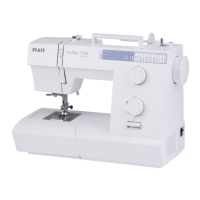2:12
C
D
E
A
B
F
Utility stitches and practical sewing
Automatic Buttonhole
Buttonholes are generally sewn onto a
piece of doubled fabric. However, for
some materials, e.g. silk, organza and
viscose, it is necessary to use stabilizer to
prevent the material from puckering.
To produce beautiful buttonholes,
embroidering or darning threads are
ideally suited to this purpose.
Mark the starting point of the buttonhole
either with a magic pen or dress pin, and
always sew a sample buttonhole À rst,
using the actual fabric
Note: The size of buttonhole is automatically
determined by placing the button in the
automatic buttonhole foot R.
The button holder of the foot takes a
button size up to 2.5 cm (1") in diameter.
Use stabilizer on stretch fabrics and check
the settings.
Turn the handwheel toward you to raise
the needle to its highest position. Attach
the automatic buttonhole foot.
To open the button holder (A), pull to the
back and place the button in it. Push back
the button holder against the button to
keep it in place.
Pull the buttonhole lever (B) down as far
as it will go.
Raise the foot and pass the needle thread
through the opening in the foot (C). Pull
both needle and bobbin threads to the left.
Insert the fabric under the foot and lower
the needle into the starting point using
the handwheel. Lower the presser foot.
Note: Make sure there is no gap between the
slider (D) and front stopper (E). If there is a
gap, the length of the right and left rows of the
buttonhole will differ(F).
A 4-5 0.5-1 1-5 R
stitch

